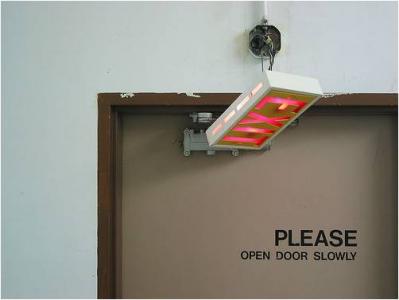- 44 reads
Spend $40 now and SAVE $38 each year... ROI = 93.8%
Office Exit Signs - Exit signs may be small, but they are illuminated 24 hours per day, seven days per week, so their energy use adds up. Exit signs formerly used incandescent lamps (usually two 20 or 40-watt lamps). Some of these older exit signs have been converted to use compact fluorescent lamps (CFLs). The CFLs last longer and use less energy, but CHANGE THEM TO LEDs!
The CFL powered exit signs with the same light output result in energy savings of 60 percent or more. Other efficient exit signs use light emitting diodes (LEDs), neon lighting, or electroluminescent lighting technology. The total energy use for these LED exit signs ranges from 1 to 10 watts. These technologies offer a maintenance benefit as well. LED, neon, and electroluminescent lighting technologies last much longer than incandescent lamps. Typical incandescent exit signs run on an average of two 30 watt bulbs (60 Watts Total), and they are on all day, every day. At 186 hours/week each one uses 11,160 watts per week. Ten exit signs use 111,600 watts or 11.6 Kilowatt Hours per week. A Kilowatt Hour is 1,000 watts of energy used over an hour. So 1 kWh is needed to power ten 100 Watt light bulbs for an hour.
To put it in perspective, running ten exit signs for a week is equivalent to powering 11 100 watt light bulbs for an hour, or powering over 33 Compact Fluorescent Lights. The kWh costs vary across US regional and power utility companies, but a kWh typically costs between $.10 and $.15 with $.12 as the US average cost. So, running ten exit signs costs $1.40 (1.8 kWh x $.12/KWh) per week. The monthly cost is $5.60, and over twelve months you spend about $67.20. Since CFLs save over 50% of the energy costs you can save over $33.70 per year for each set of ten bulbs. The cost of the Compact Fluorescent Lights is about $4 each, so you need to spend $40 to save over half of your exit sign power consumption. Remember the CFL bulbs also last 9 to 10 times also long as the incandescent, so you also save on replacement and labor. This savings can really add up for large offices, but for small offices every little saving not only impacts the bottom line, but it contributes toward a more sustainable work environment. Now that LED cost have come down so dramatically, it pays to make the switch to LEDs.
Just imagine the impact from the aggregate millions of small offices across the US that could reduce electricity demand and, in turn, reduce our need to burn coal to produce that electricity. This tactic is more about environmental stewardship than a significant impact on your bottom line.
| Payback Time in Years: | Added Cost: | Annual SAVINGS | 5 Year SAVINGS | Return on Investment (ROI): |
|---|---|---|---|---|
| 1.1 | $40 | $38 | $188 | 93.8% |
When it comes to the stairwells...due to most building codes, you have no choice but to keep the lights on 24/7 in your fire stairwells. Therefore, you might as well use the most energy efficient lighting technology available today. LED lighting not only uses on average 80% less energy than conventional technologies, but also lasts 5 to 10 times longer. This means that your maintenance people or facility managers only need to change out the bulbs once every 8 to 10 years in the stair towers, compared to fluorescent fixtures, which could need changing 5 times or more over the same period. You save on energy as well as labor and tube replacement costs. The payback with LEDs typically comes in less than a year and half!
For Specialty Auditing, go for a Lighting Energy Audit. Since the latest generation of LED Lights is one of the most cost effective retrofits, you can see paybacks on 24/7 areas like fire stairs within a year and half and other areas within three years.
Make it easy on yourself and work with a qualified lighting provider: Easy Lighting Upgrades
Go for a US LED manufacturer, to compare prices and options.


